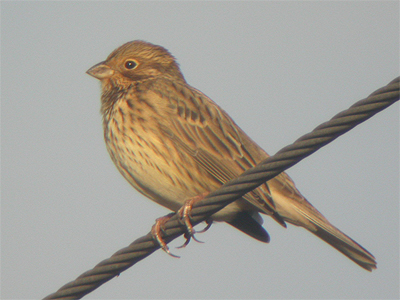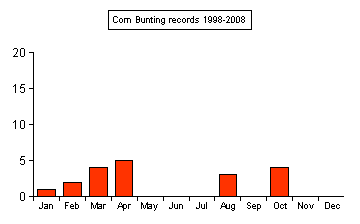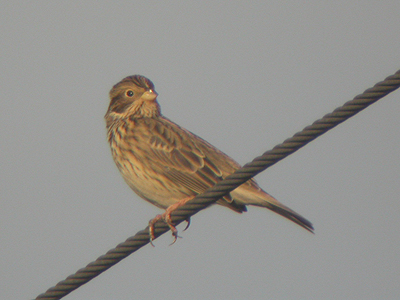

| Corn Bunting records at Eakring and Kersall 1998-2007 |
| Not seen at Eakring now for over four years, the former annually occurring Corn Bunting seems hardly likely to return as a breeding bird within the foreseeable future. This page looks at the area's records since 1998 and it's past and present Nottinghamshire status. |
| .... | ||
 |
The Corn Bunting represents the Eakring area's rarest farmland species. Between 1998 and 2007, this bird has only ever occurred here as a passage or dispersal record, but it's status has changed considerably since 2003. This is a scarce and local resident in Nottinghamshire generally, but I still expected there to be more Eakring records of the UK's largest bunting than there have been to date. Since coverage began here back in November 1997, there have been a total of just 19 records. Most of these relate to single birds, with two records involving groups of eight and nine birds being the only exceptions. Corn Bunting was annual here until 2003, which incidentally, was one of two relatively bumper years for records. 1999 produced a total of six different records, with 2003 producing five. Since this last bumper year, the Corn Bunting has not been recorded at all. |
|
| .... | ||||||||||||||||||||||||||||||||||||||||||||||||||||||||||||||||||||||||||||||||||||||||||||||||||||||||||||||||||||||||||||||||||||||||||||||||||||||||||||||||||||||||||||||||||||||
| At the time, there was nothing to suggest that this bird would be missing off the year list in coming years. It was always a tricky species to get here, but by the end of April (and for six years) had always occurred during those first four months of the year. On reviewing the records, a clear picture of Corn Bunting movements over the area emerged. The table below only depicts the actual number of records, rather than the total number of birds. From a single January record, a peak is later reached in April. Corn Buntings away from this March-April period are unusual. | ||||||||||||||||||||||||||||||||||||||||||||||||||||||||||||||||||||||||||||||||||||||||||||||||||||||||||||||||||||||||||||||||||||||||||||||||||||||||||||||||||||||||||||||||||||||
| .... | ||||||||||||||||||||||||||||||||||||||||||||||||||||||||||||||||||||||||||||||||||||||||||||||||||||||||||||||||||||||||||||||||||||||||||||||||||||||||||||||||||||||||||||||||||||||
| Perhaps surprisingly,
there are no records for September, yet there are three
from August and four from October. The three October
records I have for Corn Bunting here, do fall in very
nicely with the migration pattern of both Reed Bunting
and Yellowhammer. These two species have produced peak
migration counts during the second week of October, but
there is a difference within directional movement. Passage Corn Buntings have shown much more variation than that shown by either Yellowhammer or Reed Bunting during both migration periods. There seems to be no distinct seasonal movements by this species that get picked up annually by visible migration enthusiasts and probably many of the records here, would refer to wandering or dispersing birds rather than anything else. |
 |
|||||||||||||||||||||||||||||||||||||||||||||||||||||||||||||||||||||||||||||||||||||||||||||||||||||||||||||||||||||||||||||||||||||||||||||||||||||||||||||||||||||||||||||||||||||
| .... | ||||||||||||||||||||||||||||||||||||||||||||||||||||||||||||||||||||||||||||||||||||||||||||||||||||||||||||||||||||||||||||||||||||||||||||||||||||||||||||||||||||||||||||||||||||||
| Visible migration records of Corn Bunting at Eakring from 1998-2007 | ||||||||||||||||||||||||||||||||||||||||||||||||||||||||||||||||||||||||||||||||||||||||||||||||||||||||||||||||||||||||||||||||||||||||||||||||||||||||||||||||||||||||||||||||||||||
| .... | ||||||||||||||||||||||||||||||||||||||||||||||||||||||||||||||||||||||||||||||||||||||||||||||||||||||||||||||||||||||||||||||||||||||||||||||||||||||||||||||||||||||||||||||||||||||
|
||||||||||||||||||||||||||||||||||||||||||||||||||||||||||||||||||||||||||||||||||||||||||||||||||||||||||||||||||||||||||||||||||||||||||||||||||||||||||||||||||||||||||||||||||||||
| .... | ||||||||||||||||||||||||||||||||||||||||||||||||||||||||||||||||||||||||||||||||||||||||||||||||||||||||||||||||||||||||||||||||||||||||||||||||||||||||||||||||||||||||||||||||||||||
| Archive records of Corn Bunting at Eakring from 1998-2007 | ||||||||||||||||||||||||||||||||||||||||||||||||||||||||||||||||||||||||||||||||||||||||||||||||||||||||||||||||||||||||||||||||||||||||||||||||||||||||||||||||||||||||||||||||||||||
| .... | ||||||||||||||||||||||||||||||||||||||||||||||||||||||||||||||||||||||||||||||||||||||||||||||||||||||||||||||||||||||||||||||||||||||||||||||||||||||||||||||||||||||||||||||||||||||
|
||||||||||||||||||||||||||||||||||||||||||||||||||||||||||||||||||||||||||||||||||||||||||||||||||||||||||||||||||||||||||||||||||||||||||||||||||||||||||||||||||||||||||||||||||||||
| .... | ||
| Nottinghamshire
distribution and status The latest information regarding the present status within the county, is that the Corn Bunting is definitely declining. Although most agree that it is very likely to be under-recorded, the same picture would apply. The numbers at it's Nottinghamshire strongholds of Gringley, Idle Stop and Misson etc, have probably halved in the last 20 years. Away from the north of the county, there is a small population to the east and south east of Barton-in-Fabis in the south of the county. |
||
| .... | ||
| There are also small
numbers at other areas and I have seen odd singing male
Corn Buntings along the A 614, south of Bilsthorpe and a
mile or so east of Rainworth and Blidworth, but not from
anywhere else near to Eakring. The current county
recorder adds "the distribution of this species has
always been a bit odd. Absent from apparently suitable
areas and present at sites where you'd never expect
it". At first glance, there is one suitable area of Corn Bunting habitat at Eakring. This is around both Eakring Field Farm and Park Farm, roughly either side of Penny Pasture Common. Perhaps the key to the lack of Corn Buntings here and areas elsewhere, may be partly down to soil type. Eakring is situated on a clay based soil which often becomes saturated for much of the Winter. Dobbs in his book The Birds of Nottinghamshire quotes "The Trent Valley Bird Watchers carried out two surveys of this species in 1943 and 1958. It was found that the Corn Bunting in Nottinghamshire showed a marked preference for arable (especially corn) land. Distribution findings were: Carrlands - generally distributed on arable. Bunter Sandstone - although well-wooded, widespread small pockets of Corn Buntings were found on the cornland. |
 |
|
| .... | ||
| Trent Valley and
tributary valleys - common, and birds had spread to
the high ground, eg Dorkett Head, Robin Hood and Mosley
Hills. Keuper Marl upland - generally
distributed in the south, but very few reported from East
Markham northwards, where small fields and tall hedges
were though to have an adverse effect. South of the
Trent Valley - only a few on the Wolds, but well
distributed on the Trent Hills and the area bordering the
Vale of Belvoir. Eastern Notts - hardly any from
Langar to Cotham". He ends his summary with "since the above surveys, arable land (especially corn) has increased at the expense of the grassland, which coupled with the trend to larger fields, should favour an extension to this species' range" However, modern farming practice is probably responsible for much of the decline. Set-aside and set-aside strips don't seem to have helped Corn Buntings much so far and may well be removed by many farmers over the next few years. It may well be another few years before this bird appears at Eakring again. References and credits Dobbs A. 1975 The Birds of Nottinghamshire. Trent Valley/Nottinghamshire Birdwatchers Annual Report 2000. Many thanks to Steve Dunn and Andy Hall for providing information when requested. |
||